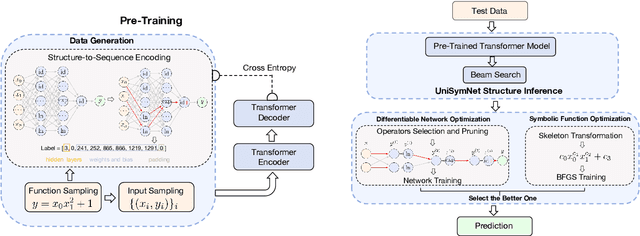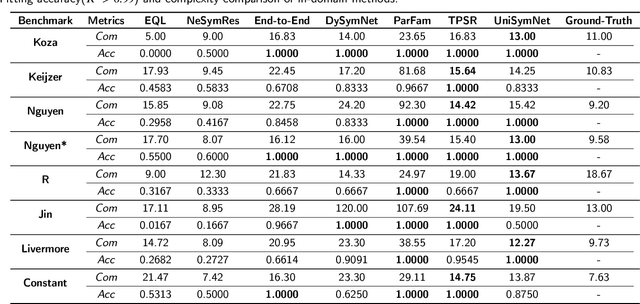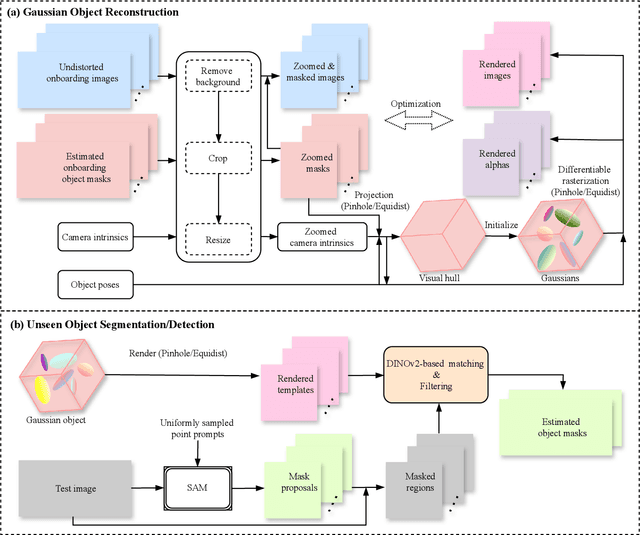Xingyu Liu
Efficient Speculative Decoding for Llama at Scale: Challenges and Solutions
Aug 11, 2025Abstract:Speculative decoding is a standard method for accelerating the inference speed of large language models. However, scaling it for production environments poses several engineering challenges, including efficiently implementing different operations (e.g., tree attention and multi-round speculative decoding) on GPU. In this paper, we detail the training and inference optimization techniques that we have implemented to enable EAGLE-based speculative decoding at a production scale for Llama models. With these changes, we achieve a new state-of-the-art inference latency for Llama models. For example, Llama4 Maverick decodes at a speed of about 4 ms per token (with a batch size of one) on 8 NVIDIA H100 GPUs, which is 10% faster than the previously best known method. Furthermore, for EAGLE-based speculative decoding, our optimizations enable us to achieve a speed-up for large batch sizes between 1.4x and 2.0x at production scale.
Dynamic Benchmark Construction for Evaluating Large Language Models on Real-World Codes
Aug 10, 2025Abstract:As large language models LLMs) become increasingly integrated into software development workflows, rigorously evaluating their performance on complex, real-world code generation tasks has become essential. However, existing benchmarks often suffer from data contamination and limited test rigor, constraining their ability to reveal model failures effectively. To address these, we present CODE2BENCH, a end-to-end pipeline for dynamically constructing robust and contamination-resistant benchmarks from real-world GitHub repositories. Specifically, CODE2BENCH introduces three key innovations: (1) Automated Dynamism, achieved through periodic ingestion of recent code to minimize training data contamination; (2) Scope Graph-based dependency analysis, which enables structured classification of functions into benchmark instances with controlled dependency levels (distinguishing between Self-Contained (SC) tasks for cross-language evaluation and Weakly Self-Contained (WSC) tasks involving permitted library usage); and (3) Property-Based Testing (PBT) for the automated synthesis of rigorous test suites to enable thorough functional verification. Using this pipeline, we construct CODE2BENCH-2505, the first benchmark derived from 880 recent Python projects spanning diverse domains, comprising 1,163 code generation tasks with 100% average branch coverage on ground-truth implementations. Extensive evaluation of 16 LLMs using CODE2BENCH-2505 reveals that models consistently struggle with SC tasks requiring complex, non-standard logic and cross-language transfer, while showing relatively stronger performance on WSC tasks in Python. Our work introduces a contamination-resistant, language-agnostic methodology for dynamic benchmark construction, offering a principled foundation for the comprehensive and realistic evaluation of LLMs on real-world software development tasks.
Overcoming Overfitting in Reinforcement Learning via Gaussian Process Diffusion Policy
Jun 16, 2025Abstract:One of the key challenges that Reinforcement Learning (RL) faces is its limited capability to adapt to a change of data distribution caused by uncertainties. This challenge arises especially in RL systems using deep neural networks as decision makers or policies, which are prone to overfitting after prolonged training on fixed environments. To address this challenge, this paper proposes Gaussian Process Diffusion Policy (GPDP), a new algorithm that integrates diffusion models and Gaussian Process Regression (GPR) to represent the policy. GPR guides diffusion models to generate actions that maximize learned Q-function, resembling the policy improvement in RL. Furthermore, the kernel-based nature of GPR enhances the policy's exploration efficiency under distribution shifts at test time, increasing the chance of discovering new behaviors and mitigating overfitting. Simulation results on the Walker2d benchmark show that our approach outperforms state-of-the-art algorithms under distribution shift condition by achieving around 67.74% to 123.18% improvement in the RL's objective function while maintaining comparable performance under normal conditions.
DREAM: Drafting with Refined Target Features and Entropy-Adaptive Cross-Attention Fusion for Multimodal Speculative Decoding
May 25, 2025Abstract:Speculative decoding (SD) has emerged as a powerful method for accelerating autoregressive generation in large language models (LLMs), yet its integration into vision-language models (VLMs) remains underexplored. We introduce DREAM, a novel speculative decoding framework tailored for VLMs that combines three key innovations: (1) a cross-attention-based mechanism to inject intermediate features from the target model into the draft model for improved alignment, (2) adaptive intermediate feature selection based on attention entropy to guide efficient draft model training, and (3) visual token compression to reduce draft model latency. DREAM enables efficient, accurate, and parallel multimodal decoding with significant throughput improvement. Experiments across a diverse set of recent popular VLMs, including LLaVA, Pixtral, SmolVLM and Gemma3, demonstrate up to 3.6x speedup over conventional decoding and significantly outperform prior SD baselines in both inference throughput and speculative draft acceptance length across a broad range of multimodal benchmarks. The code is publicly available at: https://github.com/SAI-Lab-NYU/DREAM.git
Unveiling and Steering Connectome Organization with Interpretable Latent Variables
May 19, 2025Abstract:The brain's intricate connectome, a blueprint for its function, presents immense complexity, yet it arises from a compact genetic code, hinting at underlying low-dimensional organizational principles. This work bridges connectomics and representation learning to uncover these principles. We propose a framework that combines subgraph extraction from the Drosophila connectome, FlyWire, with a generative model to derive interpretable low-dimensional representations of neural circuitry. Crucially, an explainability module links these latent dimensions to specific structural features, offering insights into their functional relevance. We validate our approach by demonstrating effective graph reconstruction and, significantly, the ability to manipulate these latent codes to controllably generate connectome subgraphs with predefined properties. This research offers a novel tool for understanding brain architecture and a potential avenue for designing bio-inspired artificial neural networks.
UniSymNet: A Unified Symbolic Network Guided by Transformer
May 09, 2025



Abstract:Symbolic Regression (SR) is a powerful technique for automatically discovering mathematical expressions from input data. Mainstream SR algorithms search for the optimal symbolic tree in a vast function space, but the increasing complexity of the tree structure limits their performance. Inspired by neural networks, symbolic networks have emerged as a promising new paradigm. However, most existing symbolic networks still face certain challenges: binary nonlinear operators $\{\times, \div\}$ cannot be naturally extended to multivariate operators, and training with fixed architecture often leads to higher complexity and overfitting. In this work, we propose a Unified Symbolic Network that unifies nonlinear binary operators into nested unary operators and define the conditions under which UniSymNet can reduce complexity. Moreover, we pre-train a Transformer model with a novel label encoding method to guide structural selection, and adopt objective-specific optimization strategies to learn the parameters of the symbolic network. UniSymNet shows high fitting accuracy, excellent symbolic solution rate, and relatively low expression complexity, achieving competitive performance on low-dimensional Standard Benchmarks and high-dimensional SRBench.
Do Retrieval-Augmented Language Models Adapt to Varying User Needs?
Feb 27, 2025Abstract:Recent advancements in Retrieval-Augmented Language Models (RALMs) have demonstrated their efficacy in knowledge-intensive tasks. However, existing evaluation benchmarks often assume a single optimal approach to leveraging retrieved information, failing to account for varying user needs. This paper introduces a novel evaluation framework that systematically assesses RALMs under three user need cases-Context-Exclusive, Context-First, and Memory-First-across three distinct context settings: Context Matching, Knowledge Conflict, and Information Irrelevant. By varying both user instructions and the nature of retrieved information, our approach captures the complexities of real-world applications where models must adapt to diverse user requirements. Through extensive experiments on multiple QA datasets, including HotpotQA, DisentQA, and our newly constructed synthetic URAQ dataset, we find that restricting memory usage improves robustness in adversarial retrieval conditions but decreases peak performance with ideal retrieval results and model family dominates behavioral differences. Our findings highlight the necessity of user-centric evaluations in the development of retrieval-augmented systems and provide insights into optimizing model performance across varied retrieval contexts. We will release our code and URAQ dataset upon acceptance of the paper.
Hierarchical Multi-Graphs Learning for Robust Group Re-Identification
Dec 25, 2024



Abstract:Group Re-identification (G-ReID) faces greater complexity than individual Re-identification (ReID) due to challenges like mutual occlusion, dynamic member interactions, and evolving group structures. Prior graph-based approaches have aimed to capture these dynamics by modeling the group as a single topological structure. However, these methods struggle to generalize across diverse group compositions, as they fail to fully represent the multifaceted relationships within the group. In this study, we introduce a Hierarchical Multi-Graphs Learning (HMGL) framework to address these challenges. Our approach models the group as a collection of multi-relational graphs, leveraging both explicit features (such as occlusion, appearance, and foreground information) and implicit dependencies between members. This hierarchical representation, encoded via a Multi-Graphs Neural Network (MGNN), allows us to resolve ambiguities in member relationships, particularly in complex, densely populated scenes. To further enhance matching accuracy, we propose a Multi-Scale Matching (MSM) algorithm, which mitigates issues of member information ambiguity and sensitivity to hard samples, improving robustness in challenging scenarios. Our method achieves state-of-the-art performance on two standard benchmarks, CSG and RoadGroup, with Rank-1/mAP scores of 95.3%/94.4% and 93.9%/95.4%, respectively. These results mark notable improvements of 1.7% and 2.5% in Rank-1 accuracy over existing approaches.
Street Gaussians without 3D Object Tracker
Dec 07, 2024



Abstract:Realistic scene reconstruction in driving scenarios poses significant challenges due to fast-moving objects. Most existing methods rely on labor-intensive manual labeling of object poses to reconstruct dynamic objects in canonical space and move them based on these poses during rendering. While some approaches attempt to use 3D object trackers to replace manual annotations, the limited generalization of 3D trackers -- caused by the scarcity of large-scale 3D datasets -- results in inferior reconstructions in real-world settings. In contrast, 2D foundation models demonstrate strong generalization capabilities. To eliminate the reliance on 3D trackers and enhance robustness across diverse environments, we propose a stable object tracking module by leveraging associations from 2D deep trackers within a 3D object fusion strategy. We address inevitable tracking errors by further introducing a motion learning strategy in an implicit feature space that autonomously corrects trajectory errors and recovers missed detections. Experimental results on Waymo-NOTR datasets show we achieve state-of-the-art performance. Our code will be made publicly available.
GFreeDet: Exploiting Gaussian Splatting and Foundation Models for Model-free Unseen Object Detection in the BOP Challenge 2024
Dec 03, 2024

Abstract:In this report, we provide the technical details of the submitted method GFreeDet, which exploits Gaussian splatting and vision Foundation models for the model-free unseen object Detection track in the BOP 2024 Challenge.
 Add to Chrome
Add to Chrome Add to Firefox
Add to Firefox Add to Edge
Add to Edge